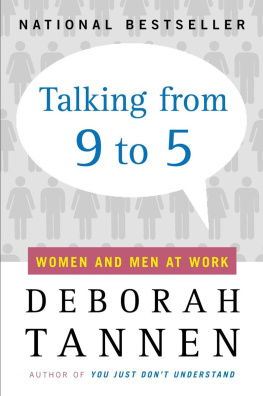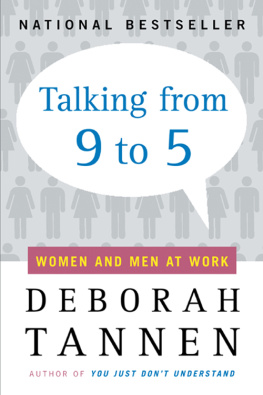Deborah Tannen - Talking From 9 to 5: Women and Men at Work
Here you can read online Deborah Tannen - Talking From 9 to 5: Women and Men at Work full text of the book (entire story) in english for free. Download pdf and epub, get meaning, cover and reviews about this ebook. year: 1995, genre: Science. Description of the work, (preface) as well as reviews are available. Best literature library LitArk.com created for fans of good reading and offers a wide selection of genres:
Romance novel
Science fiction
Adventure
Detective
Science
History
Home and family
Prose
Art
Politics
Computer
Non-fiction
Religion
Business
Children
Humor
Choose a favorite category and find really read worthwhile books. Enjoy immersion in the world of imagination, feel the emotions of the characters or learn something new for yourself, make an fascinating discovery.
- Book:Talking From 9 to 5: Women and Men at Work
- Author:
- Genre:
- Year:1995
- Rating:4 / 5
- Favourites:Add to favourites
- Your mark:
- 80
- 1
- 2
- 3
- 4
- 5
Talking From 9 to 5: Women and Men at Work: summary, description and annotation
We offer to read an annotation, description, summary or preface (depends on what the author of the book "Talking From 9 to 5: Women and Men at Work" wrote himself). If you haven't found the necessary information about the book — write in the comments, we will try to find it.
Talking From 9 to 5: Women and Men at Work — read online for free the complete book (whole text) full work
Below is the text of the book, divided by pages. System saving the place of the last page read, allows you to conveniently read the book "Talking From 9 to 5: Women and Men at Work" online for free, without having to search again every time where you left off. Put a bookmark, and you can go to the page where you finished reading at any time.
Font size:
Interval:
Bookmark:

TALKING FROM 9 TO 5
Women and Men
at Work
DEBORAH TANNEN, Ph.D.

Contents
TO ADDIE AND AL MACOVSKI
I n my mind, this book is the third in a series. In Thats Not What I Meant!: How Conversational Style Makes or Breaks Your Relations With Others, I laid out the framework of conversational style that I have spent the last two decades researching. That framework is a linguistic approach to understanding relationships: People have different conversational styles, influenced by the part of the country they grew up in, their ethnic backgrounds and those of their parents, their age, class, and gender. But conversational style is invisible. Unaware that these and other aspects of our back-grounds influence our ways of talking, we think we are simply saying what we mean. Because we dont realize that others styles are different, we are often frustrated in conversations. Rather than seeing the culprit as differing styles, we attribute troubles to others intentions (she doesnt like me), abilities (hes stupid), or character (shes rude, hes inconsiderate), our own failure (whats wrong with me?), or the failure of a relationship (we just cant communicate).
In You Just Dont Understand: Women and Men in Conversation, I narrowed the focus to patterns of conversational style influenced by gender. Based on the assumption that we learn styles of interacting as children growing up, and that children tend to play in sex-separate groups in which very different styles are learned, practiced, and reinforced, the book proceeded from the metaphor of male-female conversation as cross-cultural communication.
The two earlier books are about private speaking, focusing primarily (though not exclusively) on one-on-one conversations between intimates and friends. This book is concerned with private speaking in a public contextthe talk that goes on at work, particularly in offices. It is private in the sense that many of the conversations I analyze are still one-on-one, except for meetings and presentations. They are also private compared to the public con-texts of speaking on radio or television, or giving a lecture. Yet the work setting is public, in that most of the people you talk to at work are not family you know intimately, nor friends or partners you have chosen, but strangers into whose midst you have been thrown by the circumstances of your job. Another way that work mixes public and private is simply a matter of time: Although our private relationships with family and friends are the center of our emotional lives, many of us spend more hours of our lives at work with colleagues and coworkers, some of whom eventually become friends or even family.
There is another sense in which talk at work is public. No matter how private a conversation is, in most work settings your performance will be evaluated at some point, by a boss, a board, a client, a colleague, or a subordinate. Conversations at work can be, in a sense, like a test. What we say as we do our work can become evidence on which we are judged, and the judgments may surface in the form of raises (or denials of raises), promotions (or their lack or their opposite), and favorable (or unfavorable) work assignments.
These three books make up what social scientists call an implicational hierarchy. Everything I said in Thats Not What I Meant! applies to the two books that follow, and everything I wrote in You Just Dont Understand applies here, even though I obviously cannot repeat those books as a preface to this one. Although I may talk about women and men, I am always aware, and remind readers to be aware, thatas Thats Not What I Meant! shows in detailgender is only one of many influences on conversational style. Each individual has a unique style, influenced by a personal history of many influences such as geographic region, ethnicity, class, sexual orientation, occupation, religion, and age as well as a unique personality and spirit. Patterns that I describe are always a matter of degree, of a range on a continuum, not of absolute difference, when it comes to gender as well as the other influences and affiliations I just mentioned. In other words, our ways of talking are influenced by every aspect of our communities, so no two women or two men are exactly alike, any more than any two New Yorkers or Spaniards or forty-year-olds are necessarily alike. Yet understanding the patterns of influence on our styles is crucial to understanding what happens to us in our conversationsand our lives.
Although I am aware of the many influences on conversational style and have spent most of my career studying and writing about them, in this book, as in You Just Dont Understand, style differences influenced by gender receive particular attention. This is not only because these are the differences people most want to hear about (although this is so and is a factor), but also because there is something fundamental about our categorization by gender. When you spot a person walking down the street toward you, you immediately and automatically identify that person as male or female. You will not necessarily try to determine which state they are from, what their class background is, or what country their grandparents came from. A secondary identification, in some places and times, may be about race. But, while we may envision a day when a director will be able to cast actors for a play without reference to race, can we imagine a time when actors can be cast without reference to their sex?
Few elements of our identities come as close to our sense of who we are as gender. If you mistake peoples cultural back-groundyou thought they were Greek, but they turn out to be Italian; you assumed theyd grown up in Texas, but it turns out theyre from Kentucky; you say Merry Christmas and they say, we dont celebrate Christmas; were Muslimit catches you off guard and you rearrange the mental frame through which you view them. But if someone you thought was male turns out to be femalelike the jazz musician Billy Tipton, whose own adopted sons never suspected that their father was a woman until the coroner broke the news to them after his (her) deaththe required adjustment is staggering. Even infants discriminate between males and females and react differently depending on which they confront.
Perhaps it is because our sense of gender is so deeply rooted that people are inclined to hear descriptions of gender patterns as statements about gender identityin other words, as absolute differences rather than a matter of degree and percentages, and as universal rather than culturally mediated. The patterns I describe are based on observations of particular speakers in a particular place and time: mostly (but not exclusively) middle-class Americans of European background working in offices at the present time. Other cultures evince very different patterns of talk associated with genderand correspondingly different assumptions about the natures of women and men. I dont put a lot of store in talk about natures or what is natural. People in every culture will tell you that the behaviors common in their own culture are natural. I also dont put a lot of store in peoples explanations that their way of talking is a natural response to their environment, as there is always an equally natural and opposite way of responding to the same environment. We all tend to regard the way things are as the way things have to beas only natural.
The reason ways of talking, like other ways of conducting our daily lives, come to seem natural is that the behaviors that make up our lives are ritualized. Indeed, the ritual character of interaction is at the heart of this book. Having grown up in a particular culture, we learn to do things as the people we encounter do them, so the vast majority of our decisions about how to speak become automatic. You see someone you know, you ask How are you?, chat, then take your leave, never pausing to ponder the many ways you could handle this interaction differentlyand would, if you lived in a different culture. Just as an American automatically ex-tends a hand for a handshake while a Japanese automatically bows, what the American and Japanese find it natural to say is a matter of convention learned over a lifetime.
Next pageFont size:
Interval:
Bookmark:
Similar books «Talking From 9 to 5: Women and Men at Work»
Look at similar books to Talking From 9 to 5: Women and Men at Work. We have selected literature similar in name and meaning in the hope of providing readers with more options to find new, interesting, not yet read works.
Discussion, reviews of the book Talking From 9 to 5: Women and Men at Work and just readers' own opinions. Leave your comments, write what you think about the work, its meaning or the main characters. Specify what exactly you liked and what you didn't like, and why you think so.









